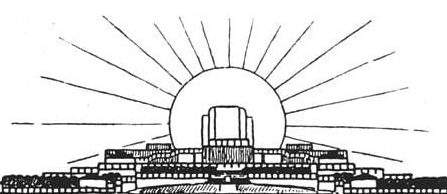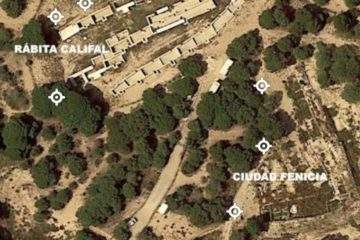The crown of the city

This post will explain the concept of the Crown of the city, one of the antecedents of the Modern Movement. A century has passed since this utopian approach, expressed in response to the rapid social changes caused by the Great War. An analogy can be established by bridging the gap with the current situation, in which great social changes have appeared in a very short time. The changes are underway who knows what our cities will be like in a century.
After the end of the First World War, Germany found a great cultural evolution. Contemporary to the german revolution of November 1918. This led to the creation of the first artists and intellectuals associations, embodied in the creation of the Novembergruppe (November group) and the Arbeistrat für Kunst (art work council). That will last two and a half years.
Although from 1919 the director of the latter is Gropius, its main figure is Bruno Taut. It develops a utopian and new architecture, with a religious background, far from urban life and the bourgeois market. The Arbeistrat für Kunst published brochures, organized conferences and two exhibitions dedicated to architecture: in 1919, the Exhibition of Unknown Architects, and in 1920, New Architecture.
In the latter, illustrations from the books by Taut Alpine Architektur and Der Weltbaumeister were shown. Chronologically these groups coincide with the creation in 1919 of the Bauhaus. Its key man, Bruno Taut, collaborates with the group that works voluntarily and deliberately on the plane of utopia.
As Germany rebuilt itself, the expressionist architects tried to approach that new beginning from the plane of utopia. As Paul Scheerbart said “it is not the end of an era, but the beginning”. Bruno taut, in the same 1918, he pointed out that «the diverse and torn tendencies will only be able to find their way, back to a unity, under the wings of a new architecture ...
Die Stadtkrone
These ideas crystallize in the work: «Die Stadtkrone»(1919) (The Crown of the City). In which Taut describes his utopian city. Which would be crowned by a glass cathedral that would serve as a reference point for the city itself. This city cannot start from an existing metropolis, because according to Taut they are rotten. To create a new way of building you have to start from scratch. And that is why he places the utopian city at the antipodes of the metropolis.
For Taut, architecture had to be all light and glass, as he had already seen in his Glass Pavilion at the Werkbund Exhibition in Cologne. In 1914, the symbolism that Bruno Taut intended to give to glass came, in part, from the metaphysical novels of Paul Scheebart. A visionary writer of novels and short stories describing glass architecture, Taut met in 1912. In 1914 he published the book Glasarchitektur (Glass Architecture), which he dedicated to Taut. Taut's Alpine Architektur was also a tribute to Scheerbart, who had died in 1915.
Paul scheebart
Paul scheebart He greatly influenced Bruno Taut giving himself an affinity in the way of thinking and conceiving the architecture of both. They agreed on the intention of replacing the unsightly industrial brick of the cities with glass. The transparency of this and its coloration would transform the pure and uncontrolled light into something mystical and divine, as it happened in Gothic cathedrals. But his intention is not only mystical, but tries to develop a new way of living, in which the idea of glass as a cold material would be modified. Glass is for Taut the symbol of peace and cooperation between peoples, and from that conviction his writings and projects arise, in which the architecture of glass and that of color come together.
These theories partially came true when he was appointed architect of Magdeburg in 1921, where he planned in collaboration with its inhabitants, the reform of the Siedlung and built houses painted by its inhabitants in bright colors. In this way, the inhabitants of their houses participated in the architecture itself. In 1920 Bruno Taut publishes the book Der Welbaumister (The Builder of the World), in which through forty engravings he develops the architectural spectacle that has its beginnings in a Gothic cathedral that is destroyed, among whose remains emerge the earth, society, a house and a palace of multi-colored glass.
conclusion
Taut points to themes that will develop widely with the Modern Movement. As are the housing, urban monuments and the shape of the city. All this related to glass architecture. The group formed around Taut in 1919 is made up of architect-painters who did not manage to carry out any work, such as Paul Gösch, Wenzel-August Hablick and Hermann Finsterlin. But also of others who over time carry out important projects, as in the case of Hans Scharoun, in charge of rebuilding the city of Berlin.



5 Comments
Google · at
One of our guests lately recommended the following website.
Google · at
Just beneath, are quite a few absolutely not connected web pages to ours, nonetheless, they may be surely really worth going over.
tantric massages in london · at
I loved your article. Cool.
Joesph man · at
I simply want to say I am just beginner to blogs and truly savored you're page. Almost certainly I'm likely to bookmark your website. You amazingly come with great writings. Thanks for revealing your website page.
Kris penha · at
I simply want to tell you that I am just beginner to blogging and actually loved your website. More than likely I'm want to bookmark your website. You really have amazing articles and reviews. Thanks for sharing with us your web-site.